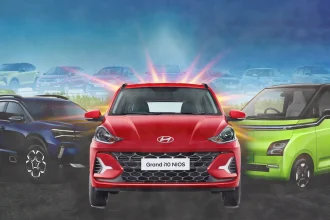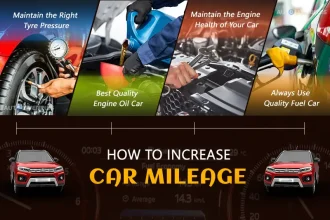Are you looking for a new car and confused by all the complicated jargon out there? Or maybe you’re just curious and want to know more about hatchbacks. Well, we’re going to cut right to the chase and answer the pressing question, ‘What is a hatchback car, really?’
Keep reading to learn more about exactly what a hatchback car is, as well as its classifications, advantages, and some trivia as well!
What Is A Hatchback Car?
So, what is a hatchback car? First, the easy explanation. A hatchback is a small car that has a storage area that is connected to the rear seating area. The storage space can be accessed from inside the car itself. These cars also have a larger rear opening that is hinged at roof level and opens upwards. For context, a sedan’s boot opening is hinged below the rear window.
Now let’s get into the slightly more detailed description of a hatchback. A hatchback is built with a two-box body design. So one box holds the driver, and the other holds the rear passengers and the cargo. On the other hand, a sedan has a three-box design where the boot is separate from the rear passenger seating space.
Have you, by chance, come across a car described as having five doors? The rear opening of a hatchback’s boot is technically classified as a separate door, so hatchbacks are classified as five-door cars. A removable parcel shelf or a roll-up tonneau cover is used to separate the cargo and seating space.
Hatchbacks can also be two-seater, three-door affairs, but these models aren’t offered in India at all.
The Evolution Of The Hatchback:
The hatchback has come a long way from the beginning. Earlier, they were small, compact, and cheap, with boxy silhouettes and sterile interiors. Today, the hatchback car segment is highly competitive. You can easily find good-looking, well-equipped hatchbacks in the Indian automobile industry.
Many sedans discreetly come equipped with a proper rear hatch. Due to their sloping rooflines, some hatchbacks are marketed as SUVs or ‘four-door coupes’. This may be done to avoid the ‘cheap, economical car’ opinion of hatchbacks that was formed during its early years.
Types Of Hatchbacks
Like we’ve mentioned earlier, today’s hatchbacks are incredibly diverse. They range from incredibly affordable economy cars to more luxurious offerings.
A-Segment-Mini-Hatchbacks
Small hatchbacks constitute the bulk of the Indian hatchback segment. These are also some of the smallest and most compact 4-seater cars you’ll find in India. They are smaller than 4 meters or 3699 mm, in length and usually provided only with a petrol engine. They are cheap and economical, and they are equipped with a decent amount of safety and comfort features.
A-segment hatchbacks make good commuter cars as their small size allows them to zip through traffic. Some popular A-segment hatchbacks are:
B-Segment Small Hatchbacks
Next, let’s take a look at some B-segment hatchbacks. These are wider and taller than their A-segment counterparts. They have more powerful engines and also come with better-equipped interiors. These small hatchbacks are great for slightly longer distances. You can choose between petrol and diesel engines and even opt for automatic transmission.
B1 segment hatchbacks measure between 3700 and 3849 mm. B1 segment hatchbacks in India include:
B2 segment hatchbacks are slightly longer, at 3850 to 3999 mm. These include:
Exceptions
Some cars don’t fit neatly in a single category. Even the world of hatchbacks has exceptions. You may have noticed that hatchbacks are limited to the A and B segments in India. The C and D segments are typically reserved for bigger, bulkier cars with hefty price tags. So what is a hatchback car with a luxury price tag marketed as? Let’s take a look at a few examples.
Though the luxury hatchback is a niche product in India, this isn’t a very competitive segment due to the limited number of available choices. These hatchbacks may be compact or slightly larger, but they share one thing in common: a hefty price tag.
- MINI cars such as the MINI Cooper or the MINI Countryman are classified as luxury subcompact hatchbacks. Due to their size and price point, they do not have any direct competitors in India.
- Audi calls their hatchback cars ‘sportbacks’ as they have a sportier style and are more luxurious on the inside. The Audi S5 Sportback costs between 77.32 and 83.15 lakh.
- The BMW 6-Series GT is marketed as a sedan in India, and while its design is slightly sedan-like, it features a proper hatch that is connected to the rear seating area. It is priced starting at 73.50 lakh.
- The Mercedes-Benz AMG A45 S is a sporty A-Class hatchback geared for high performance. With the world’s most powerful turbocharged four-cylinder engine, this car is the largest and most expensive hatchback offered in India. It is priced starting from 93.65 lakh.
Hot Hatches
If you’re a car enthusiast, you’ve no doubt heard of this term before. But if not, let us enlighten you. A hot hatch is a hatchback with a powerful engine and driving dynamics that has been tweaked for sporty performance. Hot hatches are exactly fun to drive as they are light and agile thanks to their small size, with sharp throttle response and a great power-to-weight ratio.
Unfortunately, the Indian market is budget-oriented and does not favor hot hatches. However, these discontinued models still fetch good prices in the used car market:
- Volkswagen Polo GT
- Honda Civic Type R
- Ford Fiesta ST
- Fiat Abarth Punto
Currently, the Hyundai i20 N Line and the Tata Altroz Racer are the only new hot hatches you can buy in India.
Did You Know?
The first ever production hatchback was made by French automaker Citroen. Called the ‘11 CV Commerciale,’ it was a hatchback version of the Citroën Traction Avant series. This car was marketed to tradesmen like bakers, butchers, and grocers, as the hatch allowed for greater storage space. Today, Citroen sells two hatchbacks in India: the Citroen C3 and the Citroen eC3.
Advantages Of Hatchbacks
What is a hatchback car useful for? Hatchbacks have many practical uses and also have many advantages over cars of other body types.
Comfortable and Spacious Interior
Since hatchbacks are small cars, you might be under the assumption that they aren’t very spacious inside. That isn’t true at all, though. Sedans and even some SUVs have low, sloping roofs that look good from outside but severely limit headroom on the inside, especially for rear passengers. Thanks to the higher ceiling, a hatchback’s second-row seats offer great headroom even for taller passengers.
Compact Size
We all know what Indian roads are like. Cramped and narrow roads with slow moving traffic are the norm. However, smaller cars are much easier to navigate in traffic than larger ones. Hatchbacks are light and zippy and easy to handle. They’re the ideal car for commutes, running errands, and picking the kids up from school.
Your hatchback can easily drive on narrow streets and its short tuning radius makes reversing, turning, and parking a breeze. Since they take up less space, they are easier to park as well. You can park your hatchback in tight parking spaces and they won’t obstruct other cars due to their small footprint.
Fuel Efficiency
In India, fuel is expensive. We’re used to petrol, diesel, and even CNG prices rising constantly. So buying a car with good mileage becomes a priority of the highest order. In fact, it may very well be the sole reason for choosing one car over the other. It shouldn’t be surprising to learn that hatchback cars are incredibly fuel-efficient.
What is a hatchback car doing that makes it more fuel-efficient than other body types? For one, it is smaller and therefore lighter. A light car requires less power to move than a heavy car. Secondly, the engines used are smaller and thus use less fuel. This means that there’s a huge difference between the mileage offered by a hatchback and an SUV. Thanks to great mileages, you’ll save a lot of money on fuel costs.
Affordable Maintenance
Hatchbacks are cheaper to own than other car types as they have fewer maintenance costs. Every car owner knows that since maintenance is a recurring cost after purchase, it must be taken into consideration while buying a new car. Hatchbacks are relatively simpler machines than other cars. Thus, they are straightforward and easy to repair.
Since most problems are easily fixable, they won’t cost you a lot. Even major problems won’t be expensive to fix. Since they are economical cars, their parts are cheap and easy to obtain as well.
The Learner’s Car
What is a hatchback car like to drive? Hatchbacks are simpler cars than sedans or SUVs and are thus easier to drive. They offer good visibility, smooth gear shifts, a stable ride, and easy braking. Easy to steer, handle, and navigate in traffic thanks to their small size, hatchbacks make great cars for first-time drivers.
You’ll find that many driving schools use hatchbacks as their learner cars. Along with affordable maintenance, additional modifications to a hatchback are also relatively cheap.
A Good First Car
Entry-level A-segment hatchbacks are the cheapest cars you can buy. Hatchbacks are some of the most affordable cars in India. They are marketed towards the middle class. Many people buy hatchbacks when upgrading from a two-wheeler to a car.
Hatchbacks are also the preferred choice of budget buyers, as they offer good value for money. They are often the first cars that many buy as they are easy to drive, affordable, and have good mileage. About 46% of first-time car buyers in India opt for a hatchback.
Cargo Capability
What is a hatchback car’s cargo capacity like? The hatchback can carry larger and bulkier cargo when compared to a sedan of the same size. This is due to the lack of a package tray and flip-up rear hatch that doesn’t restrict cargo height. The hatch door doesn’t get in the way and makes loading and unloading the boot much easier.
Many hatchbacks offer folding rear seats. So when only the driver and front passenger are traveling, the rear seats can be folded down to create a larger storage area. As hatchbacks have spacious rear seating, the volume capacity of the car doubles when the seats are folded down.
Did You Know?
While hatchbacks still enjoy a lot of popularity in India, they are not as in-demand in certain other countries. Notable examples include the North American market. On the other hand, hatchbacks are immensely popular in Europe, as they are considered more practical and sporty than sedans.
The Difference Between SUVs, Crossovers, And Hatchbacks
Crossovers and SUVs also have two-box body shapes with rear hatches. Does that make them hatchbacks too? No, and in order to understand why, let’s refresh what we’ve learned about what a hatchback car is.
So, what’s a hatchback vehicle and what’s not? A hatchback must have a hatch, but it must also be compact. So cars with the hatchback body style should typically measure below 4 meters in length. Any longer, and carmakers are forced to market them as sedans or SUVs. However, many SUVs and vans may look like hatchbacks but have vertical backs and may also use a D-pillar—both features you won’t find in a typical hatchback.
Crossovers are very similar to hatchbacks, but they ride higher and have a higher center of gravity. Crossovers are popular in India as they won’t get caught on speedbumps like a hatchback might. But they aren’t as easy to handle or fun to drive.
So even though some SUVs, crossovers, vans, and estate cars have the same boot style as a hatchback, they are better classified according to other design features. We hope we have provided an in-depth answer to your question, ‘What is a hatchback car?’
Frequently Asked Questions:
What is a hatchback car meaning and definition?
A hatchback car is a compact car with a shared rear passenger and cargo space. Hatchbacks have a rear ‘hatch’ door that swings upwards.
Which are some popular hatchback cars in India?
Some popular hatchbacks in India include the Maruti Suzuki Alto, the Tata Tiago, the Hyundai Grand i10 Nios, etc.
Which hatchbacks offer the best mileage in India?
The Tata Tiago EV, Maruti Suzuki Dzire CNG, Maruti Alto K10 CNG, Maruti Suzuki Celerio CNG, and the Citroen eC3 offer good mileage.















